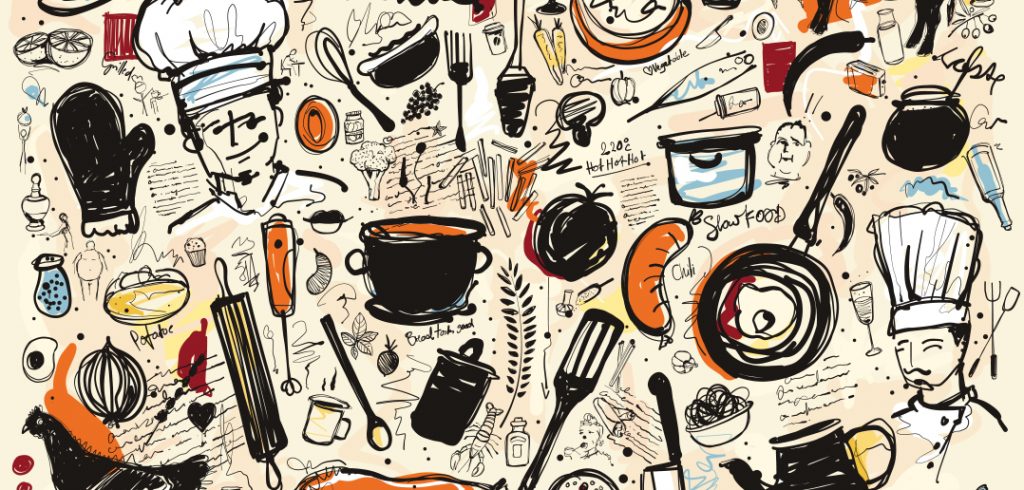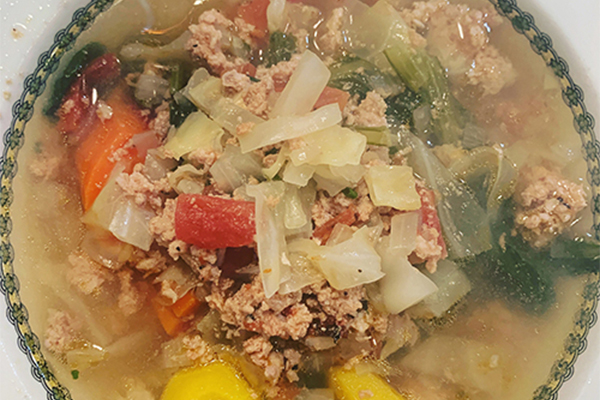Anne Fernald’s “Whatever” Soup
Anne Fernald, Ph.D., professor of English and women’s, gender, and sexuality studies, has maintained her Sunday night efforts to cook for the work week. “I realized that if I did not do it, I would revert to my natural diet, which is bread and cheese with some butter,” she says. “I do nothing but teach and cook these days and, in a welcome development, my husband has been cooking a tiny bit, too.” Her favorite recipe hails from The New York Times’ Samin Nosrat. It’s called Whatever You Want Soup, and it “serves as a canvas for any kind of chunky soup,” Nosrat writes. Here is Fernald’s take on it.
Ingredients
4 tablespoons butter, olive oil, or neutral-tasting oil
2 medium onions, diced
3 cloves garlic, sliced
Kosher salt
6 to 8 cups meat, vegetables, or other add-ins
Ground turkey
Shredded cabbage
Carrots, cut into rounds
Tomato, chopped
Green onion, sliced
1 1⁄2pounds raw, boneless chicken (optional)
8 cups water or chicken stock, preferably homemade
Steps
1. Set a large Dutch oven or stockpot over medium-high heat and add 4 tablespoons butter or oil. When the butter melts or the oil shimmers, add onions and garlic, and a generous pinch of salt.
2. Reduce the heat to medium and cook, stirring occasionally, until the onions are tender, about 15 minutes.
3. Place the meat, vegetables, and other add-ins in the pot, along with the raw chicken (if using), and add enough liquid to cover. Season with salt. Increase heat to high and bring to a boil, then reduce to a simmer.
4. Cook until the flavors have come together and the vegetables and greens are tender, about 20 minutes more. If you added raw chicken, remove it from the soup when cooked, allow to cool, shred, and return to the soup. Taste and adjust for salt.
5. Add more hot liquid if needed to thin the soup to desired consistency. Taste and adjust for salt.
6. Serve hot, and garnish as desired.
Yield: 6 to 8 servings l Time: About 45 minutes
Base recipe courtesy of Samin Nosrat/The New York Times
The Raffetto Family’s Pink Rice
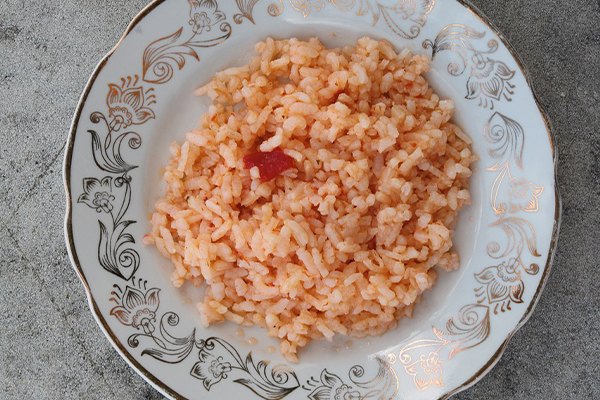
Raffetto’s has been selling made-in-house pasta and other Italian specialties on New York City’s Houston Street since 1906, spanning four generations of the family. The two most recent generations include brothers Richard, FCRH ’82, and Andrew, FCRH ’84, and Andrew’s daughter Sarah, PCS ’13. Romana Raffetto, Richard and Andrew’s mother, made this dish many times over the years. The Raffettos still make it regularly, Sarah says, because it is so delicious, comforting, and easy. “We use the Reggiano crumbs because, like Nonna taught us, we try not to waste anything, and while cutting wheels of cheese for retail we save the broken crumbs for future recipes.”
Ingredients
1 cup Arborio rice
1 ice cream scoop of salt (a common measurement in our kitchen)
4 tablespoons (1⁄2 stick) butter
4 tablespoons Raffetto’s tomato and basil sauce (or a similar sauce of your choice)
Parmigiano-Reggiano crumbs to taste
Steps
1. Bring a pot of salted water to boil. Add rice, cover, and cook for 20 minutes.
2. While the rice is cooking, you can get the butter ready by melting it in a bowl. Otherwise, make sure that the butter is out long enough to soften so it will melt easily when the rice is done cooking.
3. When the rice is cooked, strain with a fine mesh strainer and add to the bowl with butter. Stir in Raffetto’s tomato and basil sauce (or any red sauce) in tablespoon increments, adding more or less as desired.
4. Stir in Parmigiano and eat immediately while everything is warm and the cheese melts, resulting in a beautiful light pink color with chunks of tomatoes.
Note: “Nonna Romana hardly ever measured anything,” Sarah says. “She was a casual cook who
knew by eye more than numbers. Modify slightly to your needs and enjoy!”
Yield: 4 to 6 servings l Time: About 20 minutes
Taylor Ha’s Whipped Coffee

Fordham graduate student and Fordham News staff writer Taylor Ha recently recorded herself making a drink that’s gone viral amid the pandemic. Whipped coffee, a four- ingredient beverage that originated in South Korea, was recently featured on TikTok’s trending page, with more than 312,000 videos using the hashtag #whippedcoffee, according to ABC News. In their home kitchen, Ha and her mother created their own version of the popular drink, complete with a slow-motion video of the production process. They also made spaghetti aglio e olio. “Both were delicious and super satisfying to make,” Ha says. “I’ll admit I didn’t actually cook, since I was filming everything, but it was nice to bond with my mom at home.”
Ingredients
2 tablespoons sugar
2 tablespoons instant ground coffee
2 tablespoons freshly boiled water
1 cup almond milk or any other milk (enough to fill a glass 3⁄4 of the way up)
Steps
1. Combine the sugar, instant coffee, and boiled water in a small bowl, whisking the mixture until it becomes silky smooth and turns a light shade of brown. Set aside.
2. Place a few ice cubes in a glass cup and fill the cup three-quarters full with almond milk.
3. Add a few dollops of whipped coffee on top and gently stir the whole thing.
Daejah Woolery’s Jamaican Dumplings with Jerk Chicken and Butternut Squash
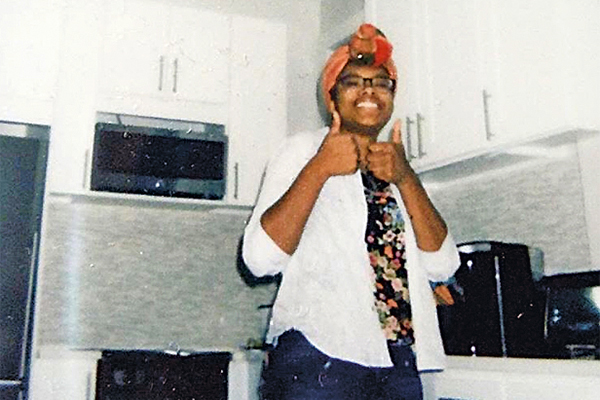
When Fordham College at Lincoln Center sophomore Daejah Woolery moved off campus, she started cooking more. She says she doesn’t always have the time to make elaborate dishes, but as a Jamaican, “food is super important to the culture,” so she makes an extra effort to cook from scratch. “I’m excited to make this for my family and show them my slight twist on Jamaican boiled dumplings with chicken!”
Ingredients
Boiled dumplings
2 cups flour
5 teaspoons salt
1⁄4 cup cornmeal
1⁄2 cup cold water
Jerk seasoning (Note: bottled jerk seasoning can be substituted.)
1 tablespoon garlic powder
2 to 3 teaspoons cayenne pepper
2 teaspoons onion powder
2 teaspoons salt
1 teaspoon paprika
1 teaspoon ground allspice
1⁄2 teaspoon black pepper
1⁄2 teaspoon dried crushed red pepper
1⁄2 teaspoon ground nutmeg
1⁄4 teaspoon cinnamon
Butternut squash, as much as you like, cut into cubes
Chicken, any cut, as much as you like, cut into cubes
(Note: I typically use 2 boneless chicken breasts and 12 oz. frozen, pureed butternut squash.)
Steps
1. Bring a large pot of water to a boil.
2. Combine flour, salt, cornmeal, and cold water. Adjust until you have a dough that doesn’t stick to your hands.
3. Make small disc-like shapes and drop them into the boiling water for about 10 minutes. Try not to overcrowd your pot! Remove from heat and set aside. Or they can remain in the water with the heat off.
4. Combine all jerk seasoning ingredients and set aside.
5. Bring another large pot of water to a boil and add squash cubes.
6. When squash is softened, after about 15-20 minutes, puree or mash it finely.
7. Heat pureed squash in a saucepan on medium-low heat and add some of your jerk seasoning to taste. Switch to low heat after you see bubbles. Add about 1⁄4 cup of water if you want a thinner sauce.
8. Season the chicken with jerk seasoning and cook it however you like; throw it in the air fryer if you’re in a rush or sauté it like I usually do.
9. Once the chicken is cooked, add it to the saucepan with the squash and resist the urge to eat it immediately. Let it simmer together on medium-low heat for 5 minutes. Make sure the chicken gets surrounded by the sauce. The sweet and nutty taste of the squash will interact really well with the jerk seasoning.
10. Transfer the dumplings to a plate and put some chicken and squash directly on top!
Yield: 4 servings l Time: About 60 minutes
Clint Ramos’ Filipino Chicken Adobo

Clint Ramos, head of design and production in the Fordham Theatre program, has won several awards, including a Tony and an Obie, for his set and costume designs. He posted a photo of his chicken adobo on Instagram that prompted inquiries about the recipe. With roots in the activist street theater scene in Manila, he advises that one eat the dish while pondering “how much of what you enjoyed was indigenous or a result of Spanish colonialism.”
Ingredients
2 pounds boneless chicken thighs (I like skin but you can also do skinless)
4 dried bay leaves
8 tablespoons dark soy sauce (I use Kikkoman)
8 tablespoons coconut vinegar (apple cider vinegar will also do well)
8 cloves garlic, peeled and crushed
11⁄2 cups water
3 tablespoons cooking (canola or any high heat) oil
1⁄4 teaspoon salt (optional—the salinity from the soy may be enough)
1 teaspoon whole peppercorns
1 teaspoon brown sugar
Steps
1. Marinate chicken in soy sauce, vinegar, and garlic for at least 3 hours or overnight in the fridge.
2. Separate chicken from marinade, removing as much of the liquid as possible. Save all of the marinade (this will be your braising liquid).
3. Heat oil in a pan on medium-high heat and brown chicken on both sides (about 2 minutes per side).
4. In the same pan, pour in the marinade (garlic and all) and water. Bring to a boil.
5. Add bay leaves and peppercorns and reduce heat to low to simmer.
6. Simmer for 30 minutes or until chicken is tender. I completely cover it for 15 minutes and let some of the steam out for the remaining 15 with a wooden spoon lodged between lid and pot. Important: Watch that the liquid reduces to a slightly thickened sauce but not completely.
7. Add sugar and cook for another 5 to 10 minutes.
8. Serve over hot white or brown rice and enjoy!
Yield: 6 to 8 servings l Time: About 60 minutes
Loren Avellino’s Banana Lace Cookies

As a first-generation Italian-American woman, Loren Avellino, FCLC ’07, says she practically grew up in the kitchen. In fact, when she got the opportunity to live in McMahon Hall for the summer as an orientation coordinator at the Lincoln Center campus, she hosted pasta nights for fellow summer residents. Today, she has a degree in culinary arts, a catering company, and a food blog. She recently started a video cooking series on her Instagram page, @lo_go_cook. “When I’m in the kitchen, my anxiety seems to melt away, and if I can take others on that journey with me, especially during these uncertain times, then I’ve done a tiny part to help during this crisis,” Avellino says.
Ingredients
1⁄2 cup (1 stick) unsalted butter, softened
1 cup white sugar
1 teaspoon white or apple cider vinegar
1 cup mashed brown bananas (about 2 large bananas)
1 teaspoon baking soda
1 cup all-purpose flour
1 cup almond flour*
1 teaspoon salt
1 teaspoon vanilla extract
1 cup dark chocolate chips
*Almond flour is important for crispy, lacy cookies (see tip on next page about using only all-purpose flour)
Steps
1. Preheat the oven to 350°F. Beat together the butter and sugar until fluffy.
2. Add the vinegar and vanilla and continue to beat until incorporated. The vinegar helps to offset the sweetness of the ripe bananas.
3. Add the baking soda in with the mashed bananas, then mix into the butter mixture.
4. Whisk together the all-purpose flour, almond flour, and salt. Add to the batter and mix until just combined.
5. Fold the dark chocolate chips into the batter.
6. Drop tablespoon-size amounts of batter onto parchment or silicone-lined baking sheet, making sure they are about 2 inches apart. You should have 42 to 48 cookies.
7. Bake 12 to 14 minutes until the edges are dark brown. (The dark color is important for crispy cookies). Let the cookies cool on the cookie sheet for at least 10 minutes before moving to a wire rack to complete cooling.
Tip: You could use only all-purpose flour, but the cookies will be denser and less crispy than the almond flour version.
Yield: 42 to 48 cookies l Time: About 45 minutes
B.A. Van Sise’s Ricotta Gnocchi with Roasted Pepper Sauce
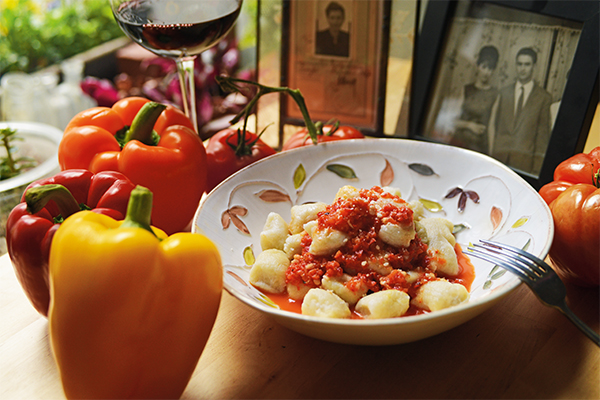
Photojournalist B.A. Van Sise, FCLC ’05, jokes that his mother preferred food “so heavy that a black hole would not easily escape its pull.” For her homemade gnocchi, she’d replace the potato with rich, creamy ricotta and make the supple dough herself, rolling it and cutting it by hand. “It’s an easy activity that does not need but asks for six hands,” Van Sise says. “Recruit your kids for help, if you’ve got them. Trust me: they’ll remember it, fondly.”
Ingredients
Pasta
2 pounds ricotta cheese
4 eggs
4 cups flour
2 teaspoons salt
1 teaspoon pepper
Sauce
1 16 oz. jar roasted red peppers
1⁄2 cup heavy cream
4 tablespoons garlic
2 tablespoons butter
1⁄2 teaspoon dried basil
black pepper
Steps
1. In a large mixing bowl, mix the ricotta and eggs. Gradually add the flour, salt, and pepper.
2. Knead well on a floured board and roll into finger-sized long rolls, then cut into pieces about 3⁄4 inch long.
3. Bring a large pot of salted water to a boil. Add the gnocchi, stirring gently from time to time to make sure they don’t mingle too much. Cook for 8 minutes.
4. Meanwhile, in a blender, add the roasted red peppers as well as about 2 tablespoons of liquid from the jar, and puree.
5. In a saucepan, sauté the garlic and butter for approximately 2 minutes until both the butter and garlic soften; add the pureed peppers, the basil, and a little bit of black pepper. Simmer for 5 minutes, then add the heavy cream and simmer for 5 more.
6. Cover the drained gnocchi with the sauce, and either serve right away or put into a preheated oven at 350 degrees for 10 minutes to crisp them up.
Yield: 4 to 6 servings l Time: About 40 minutes
Serving Those Who Are Hungry
The economic impact of the coronavirus pandemic has led to an increase in the number of people who can’t afford food and are at risk of going hungry. Fordham graduates are among the many professionals working to meet the challenges of this deepening public health crisis. Read our interviews with Camesha Grant, Ph.D., GSS ’00, ’07, vice president of community connection and reach at the Food Bank for New York City; and Janet Miller, GSS ’97, senior vice president at CAMBA, a Brooklyn-based nonprofit that provides social services to New Yorkers in need.
Additional reporting by Tom Stoelker.

